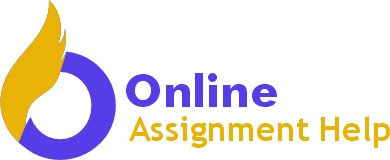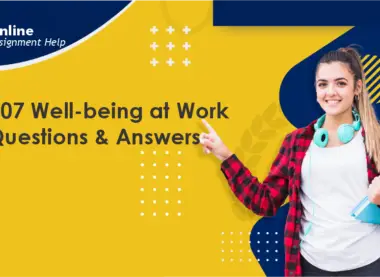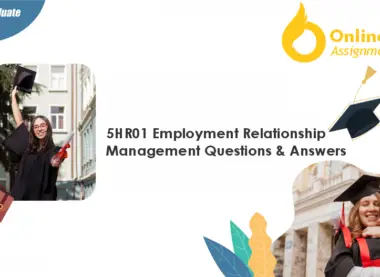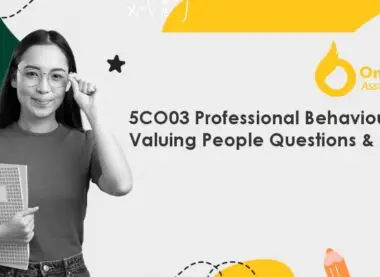Case study
You are the HR manager for Makite Solutions, a small-medium sized logistics company which distributes products nationally. Makite provide high-performance logistics and supply chain management to customers. Starting by delivering in their local area, they have experienced explosive growth over the last 3 years, becoming one of the leading lights in their sector. Makite is a unionised workplace.
This growth, however, has caused problems for Makite Solutions. Employee relations have become difficult between Makite and their staff and conflict is starting to become commonplace. Employees have mentioned “differences in personality styles”, “lack of respect” and “lack of support”. There is currently industrial unrest within the organisation, with instances of go slow tactics and talks of strikes.
As the HR manager, you have been tasked to create a policy document or factual summary of key legal aspects and their implications, for Makite’s intranet library. You will also generate an advisory briefing note to senior managers facing industrial unrest in the organisation.
Preparation for the Tasks:
- Refer to the indicative content in the unit to guide and support your evidence.
- Pay attention to how your evidence is presented, remember you are working in the People Practice Team for this task.
- Ensure that the evidence generated for this assessment remains your own work.
You will also benefit from:
Reflecting on your own experiences of learning opportunities and training and continuing professional development.
Reading the CIPD Insight, Fact Sheets and related online material on these topics.
You should relate academic concepts, theories, and professional practice to the assessment task(s), in a critical and informed way, and with reference to key texts, articles and other publications.
Task One – Policy Document
You are required to produce a policy document containing key legal aspects and their implications. This should be designed to sit on the company’s intranet and should be formal in style.
The policy document can be broken down into two sections:
Section 1
a) A review of emerging developments to inform approaches to employee voice and engagement (AC 1.1)
b) Differentiate between employee involvement and employee participation and how it builds relationships (AC 1.2)
c) Assess a range of employee voice tools and approaches to drive employee engagement. (AC 1.3)
d) Critically evaluate the interrelationships between employee voice and organisational performance. (AC 1.4)
e) Explain the concept of better working lives and how this can be designed. (AC 1.5)
Section 2
a) Explain the principles of legislation relating to unfair dismissal in respect of capability and misconduct issues. (AC 3.1)
b) Analyse key causes of employee grievances (AC 3.2)
c) Explain the skills required for effective grievance and discipline-handling procedures. (AC 3.3)
d) Advise on the importance of handling grievances effectively. (AC 3.4)
Task Two – Advisory Briefing Note
This task requires you to produce an advisory briefing note to senior managers facing industrial unrest in the organisation.
The advisory note should contain:
▪ Distinguish between organisational conflict and misbehaviour, and between informal and formal conflict. (AC 2.1)
▪ Distinguish between official and unofficial employee action. (AC 2.2)
▪ Assess emerging trends in the types of conflict and industrial sanctions. (AC.2.3)
▪ Distinguish between third-party conciliation, mediation and arbitration. (AC.2.4)
▪ Explain the main provisions of collective employment law. (AC 4.1)
▪ Compare the types of employee bodies, union and non-union forms of employee representation (AC 4.2)
▪ Evaluate the purpose of collective bargaining and how it works. (AC 4.3)
Answer
Task One – Policy Document
Section 1
- A review of emerging developments to inform approaches to employee voice and engagement
A research conducted by The Centre for People, Work and Organisational Practice at Nottingham Trent University in partnership with the CIPD and YouGov showed that approximately only half of employees in a workplace often feel satisfied with their involvement and workplace engagement (Maxwell, 2021). The research further indicated that compared to employees in smaller organisations, employees in bigger organisations feel less satisfied with their level of voice. Therefore, it is possible that as Makite solutions is growing, the employees feel less and less engaged in the decision-making process, which leaves them feeling that they lack value and voice in the organisation. Management might assume that the employees might feel represented as a unionized workplace, but the go-slows and rumours of strikes prove otherwise.
The same study indicated that while 49% of employees mentioned using team meetings to voice their opinions during team meetings, only 17% used the trade unions (Maxwell, 2021). Therefore, assuming a unionized workplace would be a conflict-free environment is reckless. It is essential to consider employee voice and engagement as employees hold the key to offering valuable knowledge and insight that management cannot due to their executive positions. Furthermore, allowing the employees to have a voice has been proven to reduce burnout while strengthening the employees’ commitment. The rapid growth that Makite solutions is experiencing might be causing a considerable amount of work pressure on the employees and causing burnout. Failing to advise or support them weakens their commitment, and the result might be catastrophic to the organisation.
- Differentiate between employee involvement and employee participation and how it builds relationships
The concepts of employee involvement and employee participation are often confused, with some seeing them as similar ideas. However, while both are significant and contribute to organisational growth, the concepts differ. Employee involvement refers to the processes and work structures that employers offer employees to participate in the actual day-to-day business activities (Hodgikinson, 2018). It allows individual employees to take part in the efficient operation of the firm. On the other hand, Employee participation refers to how employees are involved in the organisation’s decision-making process, often through representation (Hodgikinson, 2018). Employee involvement and participation bring about tremendous benefits to the organisation. There are four main ways in which a business can grow, and of them require employee involvement and participation to be successful. These four methods include expanding into new markets, innovating, efficiently performing tasks, and customer relations (Hodgikinson, 2018).
Employees are at the core of all these areas, and without involving them, many issues might go unnoticed, resulting in company failure. A good example is the collapse of Carillion, the giants of the construction industry who failed as a result of hubris, greed, and recklessness. According to the headlines, the executives in the organisation continued to increase and protect enormous bonuses at the expense of their employee’s job security and the company’s survival (Hodgikinson, 2018). It is evident that in an organisation with active employee involvement and participation, there are happier workers and good employee relations, which boost organisational productivity. Furthermore, when the employee satisfaction rate is high, there is a low turnover rate, which means that the organisation gets to maintain its best employees and continuity. It also guarantees that the customer’s needs are satisfied and that the organisation can quickly adapt to any market changes.
- Assess a range of employee voice tools and approaches to drive employee engagement.
As stated by the CIPD, an organisation with an effective employee voice strategy is a win-win situation (Maxwell, 2021). Employee voice is a method where employees can communicate their grievances to their employers about any issues that affect them at the workplace. To the employers, employee voice plays a significant role in increased productivity, innovation, and growth. For the employees, they feel valued; it increases job satisfaction and provides a better platform for improvement (Suff, 2021). An effective employee voice strategy incorporates many tools and strategies, including surveys and polls, communication initiatives, workplace meetings, email communication, suggestion boxes, employee feedback, and social functions.
Surveys and polls: There are several surveys that an organisation can undertake to ensure that they gain critical insight on employee lifecycle, employee engagement, and even quick feedback on matters that affect the organisations as well as feedback from those in management on people management skills (Suff, 2021). These surveys include new joiner surveys, census surveys, 360 feedback, and regular pulse feedback.
Communication initiatives: These include workplace meetings, social functions, listening groups, and in-person or virtual focus groups. Communication initiatives are valuable tools, especially in getting immediate feedback on issues raised in suggestion boxes and surveys. There is upward and downward communication where employees can voice their issues directly to management. Furthermore, solutions to raised issues can be immediately crowdsourced, thus preventing conflicts from escalating (Hodgkinson, 2018). Organisations should hold meetings on a regular to ensure there is constant communication between employees and management.
Online platforms: There are several ways online platforms can be a valuable tool for employee voice, including; offering online discussions and offering a platform to take suggestions and ideas into deeper details. Online platforms also offer social media review data and organisational network analysis. With advancements in technology, several platforms and applications exist to offer employees the freedom to engage and voice opinions (Holland et al., 2019). Such platforms include HighGround, Reflektive, Polly, and 15Five. In these platforms, employees can take surveys, interact with employers, have transparency on performance, rewards, and bonuses, and even have one-on-one meetings.
- Critically evaluate the interrelationships between employee voice and organisational performance.
Numerous research have shown that employee voice is one of the significant factors contributing to low productivity in many organisations. Employee voice is a collective term used to define various structures and processes that empower the employees to directly or indirectly participate in the organisation’s decision-making process (Jha et al, 2019). Therefore when management fails to listen to the employee’s voice and suggestions, the employees may choose to remain silent to the disadvantage of the organisation. When employees feel that their jobs might be at risk when they air their grievances, they may hold the information that would have been useful to the organisation.
Employee voice encourages employee participation, for it empowers the employees in influencing the actions of their employers (Jha et al, 2019). It is an excellent motivator to employee performance and employee satisfaction which has positive outcomes for both the employees and the management. Since it acts as an excellent motivator for the employees, it improves the overall work quality and experience. It improves communication and employee relations, which encourages staff retention as the employees feel valued, heard, and treated fairly (Jha et al, 2019). Employees who lack the opportunity to air their opinions feel unwanted and undervalued, resulting in a high turnover rate, absenteeism, low productivity, and poor performance. Employees’ knowledge, skills, and abilities to the organisation and some of the most valued intangible assets and lack of employee participation mean that employees lack the platform to showcase their abilities, skills, and knowledge.
- Explain the concept of better working lives and how this can be designed.
Do we live to work or work to live? It is a question often paused by members of the modern workforce. While there are hours specially designated for work, often work eats into employees’ evenings and weekends. Some employees are okay with the extra hours, while some dislike it. A study conducted by the CIPD showed that employees in the UK work for longer hours compared to their European counterparts, and many work five more hours every week than they would generally prefer (Suff, 2021). In addition to the long hours are the extra 3 hours 45 minutes spent commuting. The same study showed that nearly two-thirds of employees would like reduced hours and maintain better working lives. However, it is impossible with one out of every employee mentioning that they find it difficult to relax during the non-working hours because of their jobs. Work-life balance is crucial for each employee as it increases their productivity and creativity (Kelliher et al, 2019).
With the Makita growing in size, employees might be demoralized due to burnout caused by poor work-life balance, resulting in low productivity. It is the organisation’s role and, more specifically, the Human Resource department to make a formal and informal arrangement that would assist the employees in maintaining better working lives. The most common arrangements include flexi-time, where employees can choose when to start and finish their tasks when assigned specific working hours. However, managers must focus more on productivity rather than hours (Kelliher et al, 2019). In doing so, employees can also get opportunities to work from home where they can plan their schedule but produce output that meets organisational expectations. On informal arrangements, which are often familiar with most employees mentioning that they can quickly get such arrangements, HR can offer an employee one to two hours off to deal with personal or family matters. Incorporating these arrangements into the organisational culture shows employees that the organisation cares about their health and well-being, which motivates high productivity.
Section 2
- Explain the principles of legislation relating to dismissal in respect of capability and misconduct issues.
According to the Employment Rights Act 1996, there are five potential reasons for dismissal: conduct, capability, redundancy, a legal reason, or any other substantial reason (Employment law| CIPD, n.d). However, while the above listed are reasons for dismissal, to ensure fair handling of the process and in case of misconduct or capability issues, the employer must handle the issues according to the ACAS Code of Practice on disciplinary and grievance procedures (Employment law| CIPD, n.d). Failure to do so the employee might claim unfair dismissal even if there was a valid reason for dismissal. Some of the principles of legislation relating to dismissal include
Fairness: Despite the reason for dismissal falling within the five potential reasons for dismissal, the employer is must act fairly and reasonably in dismissing the employee.
Investigation: Dismissal is a crucial issue that could result in court cases if not handled properly. Therefore, before taking any action, managers must conduct investigations to establish facts before establishing that dismissal is the most reasonable solution (Employment law| CIPD, n.d).
Following a fair procedure: Per the Acas code, employers must consider its code of practice to ensure fair dismissal. Failure to might result in facing the employment tribunal and paying compensations to the employee.
- Analyse key causes of employee grievances
Employee grievance is the unhappiness and disappointment that arise due to factors relating to the employee’s workplace, which they feel is unjust, unfair, or inequitable. When employees raise complaints but fail to be heard or attended to, it harbours and takes the form of a grievance. Many reasons could result in a grievance ranging from a poor workplace environment to bullying. When it arises, a grievance is informal unless it is more serious, then management must undergo a formal process to solve it. Below are some of the critical causes of grievances that can leave the employee dissatisfied and cause a demotivated staff.
Inadequate Wages and Bonus: grievances are highly likely to arise if the employees fail to receive compensation for their hard work. Also, when the wages are unequal for the same work, some employees might feel undervalued and raise grievances (Joyce et al., 2020).
Unachievable and irrational targets and Standards: When management sets unreasonable and unachievable targets for the employees, they undergo stress and pressure, resulting in low staff morale and grievance.
Poor Working Conditions: Good working conditions go a long way in increasing employee satisfaction. Lack thereof, unavailability of proper machinery, tools, and safety gear is another critical factor for employee grievances.
Lack of Career Planning and Employee Development Plan: Career planning and employee development empower employees in career growth to remain relevant in their field (Joyce et al., 2020). Lack of employee development leaves them stuck in their careers, which increases employee dissatisfaction.
- Explain the skills required for effective grievance and discipline-handling procedures.
Handling grievances can quickly go sideways if the manager does not strive to handle them constructively. A grievance provides the manager with an opportunity to solve a workplace problem in the best and most fair way possible. Understanding that a problem exists within the organisation is better than ignoring that an employee is dissatisfied or unhappy with some aspect of their employment (Joyce et al., 2020). Suppose a manager fails to regard or take an employee’s grievance seriously, then the matter might escalate into two or more grievances as the employee does not feel heard. Employees at Makite solutions felt that their grievances were not being heard or taken seriously hence the rumours of strikes. For a manager to properly handle the grievances without causing any escalation, they should possess the following skills:
- Excellent listening skills, especially since finding a solution is difficult if a manager will not listen to the employee’s grievances.
- Ability to stay neutral when hearing viewpoints, even those that differ from their own
- The ability to comprehend the employee’s complaints from the company’s needs perspective.
- Strong verbal communication skills, especially being honest and straightforward without dismissing the worker.
- Advise on the importance of handling grievances effectively.
Once an employee files a complaint, the manager must respond quickly and effectively. Indeed dealing with complaints can be both difficult and time-consuming. However, any delay in addressing and resolving a complaint will worsen the situation. It may result in the employee feeling stressed due to an issue at work that they consider a challenge (Joyce et al., 2020). As a result, working relationships may be affected. Furthermore, the grievance is likely to negatively influence the employee’s productivity and performance, worsening over time.
Task Two – Advisory Briefing Note
- Distinguish between organisational conflict and misbehaviour and between informal and formal conflict.
Organisational conflict and misbehaviour
In a workplace, there are individuals from different backgrounds with varying opinions, personalities, and opposing perspectives. These factors are a brewing pot for conflict, and they result in tension which can negatively affect workplace performance. Organisational conflict is unavoidable and can occur among employees or between employees and management. If not dealt with immediately and effectively, the consequences of conflict can be disruptive and even costly to the organisation.
On the other hand, misbehaviour is an intentional act by an employee that goes against the organisational and societal norms, which results in the disruption of the system or process (Suff, 2021). It is not unheard of scenarios where employees are involved in the vandalism of organisational property, stealing, misappropriating funds, misleading customers, or sabotaging the organisation’s reputation. All these are examples of misbehaviour. There are different types of misbehaviour, i.e., Type-O whose aim is to benefit the organisation, such as trying to cheat the government, type-S whose aim is to benefit oneself, and type-D whose aim is to damage the organisation (Suff, 2021). Nonetheless, all types of misbehaviour are costly either to the individual, government, or organisation.
Informal vs. Formal conflict
As previously mentioned, conflict is a natural occurrence in any social construct, and it is therefore unavoidable in the workplace. There are instances when conflict can be beneficial, but many times, when not properly handled, it can escalate, resulting in severe repercussions for individuals or the organisation. Informal conflicts can be easily handled informally with employees or supervisors. The conflict is often handled in its early stages, and some problem-solving methods include mediation. In informal conflict, the parties involved work together and control the process to negotiate and establish a viable solution. On the other hand, formal conflict often arises when the issues are beyond employees’ control; hence management is called to intervene. Formal conflict calls for a formal process to get to a solution, including formal writings and investigations (Harcourt et al., 2021). It is often a result of an escalated informal conflict when individual discussions fail to work while seeking a solution.
- Distinguish between official and unofficial employee action.
Upon surfacing conflicts in an organisation, management ensures that these issues are resolved and avoid escalation. Several issues cause conflicts and grievances to arise in a workplace, including a call for better working conditions, unmet collective bargaining, and better pay (Harcourt et al., 2021). When employees attempt to air their grievances, but none are resolved amicably to either parties’ satisfaction, they can employ official or unofficial actions.
A trade union formally supports an official employee action, and union members participate, such as official strikes. Over the years, employees have joined trade unions to protect their employee interests. In official actions, trade unions step in on behalf of employees to negotiate and get to a solution (Harcourt et al., 2021). Only if a solution is not met, is an action taken. Official actions require to follow legal procedures to ensure that the action is protected.
On the other hand, unofficial action is not protected. Employees might choose to engage in go-slows if their grievances are not heard without any backing from trade unions. However, since the unofficial actions are not protected, employees risk dismissal (Harcourt et al., 2021). Both official and unofficial employee actions harm workplace performance. Therefore, it is essential for management to be quick in solving grievances and conflicts before they escalate to employee actions.
- Assess emerging trends in the types of conflict and industrial sanctions.
Conflicts are common in a workplace, and to ensure that they are heard or avoid being taken advantage of, employees find new ways to ensure that their demands are met. New trends are emerging where employees find new safe spaces to air their concerns (Holland et al., 2019). Traditionally, trade unions have been the go-to for employees to achieve collective bargaining. However, with more issues arising daily in the workforce, trade unions’ membership continues to experience a sharp decline as employees seek more practical and immediate solutions. One of the emerging trends in conflict and industrial sanctions is social media platforms. Social media has provided employees with the safe spaces they need to voice their issues (Holland et al., 2019). The platforms offer a large audience, including the management, legal teams, and even organisations such as the ICE (Information and Consultation of Employees). A social media exposure is enough to cost a company a lot of money for compensation and rebuild its reputation.
Another trend is eradicating tribunal fees which has provided the employees with the freedom to raise claims without any initial cost. It saw the number of employees reporting unfair dismissal rising by 65.5% between 2017 and 2018 (Holland et al., 2019). Furthermore, a 37% increase was recorded regarding disability discrimination, particularly among those with mental health. Now more than ever, employees are getting safe spaces and government protection for their employees’ interests (Joyce et al., 2020). Employees can easily plan lunchtime protests or go-slows without any backing from trade unions as social media, and the law have become protective armour.
- Distinguish between third-party conciliation, mediation, and arbitration.
Third-party conciliation- Also referred to as Alternative Dispute Resolution (ADR), third-party conciliation is voluntary and presented to an employment tribunal. It places its primary focus on issues of employment rights. An impartial third party is selected to listen to the issues presented, evaluate the available evidence, and propose a solution. However, the parties are free to accept or decline the proposed solution.
Mediation- It is an informal, voluntary process where an independent, impartial party assists the parties in conflict resolution by trying to re-establish their relationship by finding common ground on their differences. Each party offers their views on the issue privately, and the mediator encourages the parties to reach an agreement without enforcing anything (Suff, 2021).
Arbitration- It has a close similarity to mediation and ADR as all parties enter voluntarily. However, both parties must accept the arbitrator’s decision beforehand once their views and evidence are presented (Suff, 2021). The process is legally binding, and if a party does not agree with the decision, they are within their rights to appeal at an employment tribunal.
- Explain the main provisions of collective employment law.
As a branch of employment law, collective employment law focuses on regulating the behaviours and activities of employer’s associations, trade unions, and work councils and the form of relations between employers and employees (Employment law| CIPD, n.d). It looks into factors such as trade union’s freedoms to organise, trade union recognition, employee’s rights to collective consultation, lockouts, collective bargaining, Internal Union government, workers’ rights to codetermination, strikes, and any other forms of Industrial action. Collective employment law in the UK has undergone significant change over the years. The changes include narrowing the immunity offered to trade unions and the requirement that trade unions rely on postal balloting that the conservative government instituted in the 1980s and 1990s (Employment law| CIPD, n.d). More changes to the law included the introduction of statutory recognition procedure under the labour government, adopting ICE regulations, and the coming of the European Works council legislation into the UK.
- Compare the types of employee bodies, union, and non-union forms of employee representation.
Employee representation comes in two forms, either individual or group representation. Union or non-union organisations both offer representation providing both formal and informal interactions between the two sides of the industry. While both possess similarities and differences, they both aim to provide employees with a platform where they can feel free to air their grievances, offer their opinions and provide feedback on organisational changes that might affect them. One similarity between union and non-union employee representation is that an employee has the statutory right to pick any as a representation when they want support while voicing their grievances in meetings (Trade Union & Industrial Action Q&As| CIPD, n.d). Another similarity is that group issues can use both non-union and union representations. One significant difference between the two employee representations is that the non-union representation is often preferred for employees’ needs and wants that are ‘small matters.’ However, union representations are preferred when the issues are more legally binding such as redundancy. Another difference is that issues dealt with union representations often require the involvement of staff management, while non-union representations may or may not require management involvement.
- Evaluate the purpose of collective bargaining and how it works.
According to the International Labour Organisation (ILO), collective bargaining is the primary method trade unions, employees, and employers to establish better working conditions and pay. Some of the issues that call for collective bargaining include working hours, fair and equal treatment, wages, employee development, and occupational health and safety (Trade Union & Industrial Action Q&As| CIPD, n.d). It aims at coming to a collective agreement on issues to regulate the terms and conditions of the employment contract. Collective bargaining offers voice to employees, and members of trade unions can easily negotiate for their economic security and more.
How collective bargaining works:- In collective bargaining, all parties exchange ideas to develop a mutual solution and reach a written agreement. Once contact is approved, it binds both the employer and the employee. The process involved in collective bargaining include;
Preparation for bargaining: – this step involves both sides gathering information on the risen issues through meetings and surveys. It also involves reviewing the current collective bargaining contract to identify the areas that need improvement and any arising issues (Trade Union & Industrial Action Q&As| CIPD, n.d).
Conducting negotiations: – in this stage, parties negotiate on the ground rules that will help guide the negotiations. Negotiations start, and each side can propose a new bargaining area.
Ratifying the contact: – On reaching a tentative contract agreement, each party reviews the proposal with their teams to gain insight into the contract agreement and the individuals vote. The majority of the votes determine whether the new contract is rejected or ratified. If ratified, the parties reach a new agreement, and if rejected, negotiations continue until reaching an agreement.
Resolving a contract dispute: – In case of disagreement, the state law takes over to determine how to resolve the dispute.
Changing or clarifying the contract: Upon reaching an agreement, all the ratified sections of the contract are revised during the contract term.
References
Employment Law | CIPD. CIPD. Retrieved 17 February 2022, from https://www.cipd.co.uk/knowledge/fundamentals/emp-law#gref.
Harcourt, M., Gall, G., Wilson, M., & Rubenstein, K. (2021). The potential of a union default to influence the preferences and choices of non-union workers in unionised workplaces. Economic and Industrial Democracy, 0143831X211030346.
Hodgkinson, A. (2018). Employee involvement and participation in the organisational change decision: Illawarra and Australian patterns. In Models of employee participation in a changing global
Holland, P., Cooper, B., & Hecker, R. (2019). Social media at work: a new form of employee voice?. In Employee voice at work (pp. 73-89). Springer, Singapore.
Jha, N., Potnuru, R. K. G., Sareen, P., & Shaju, S. (2019). Employee voice, engagement and organizational effectiveness: a mediated model. European Journal of Training and Development.
environment (pp. 247-271). Routledge.
Joyce, S., Neumann, D., Trappmann, V., & Umney, C. (2020). A global struggle: worker protest in the platform economy. ETUI Research Paper-Policy Brief, 2.
Kelliher, C., Richardson, J., & Boiarintseva, G. (2019). All of work? All of life? Reconceptualising work‐life balance for the 21st century. Human Resource Management Journal, 29(2), 97-112.
Managing Employment Relationship | CIPD. CIPD. Retrieved 17 February 2022, from https://www.cipd.co.uk/knowledge/fundamentals/relations#gref.
Maxwell, G. (2021). Employee Voice | Factsheets | CIPD. CIPD. Retrieved 17 February 2022, from https://www.cipd.co.uk/knowledge/fundamentals/relations/communication/voice-factsheet#gref.
Suff, R. (2021). Dismissal Procedures | Factsheets | CIPD. CIPD. Retrieved 17 February 2022, from https://www.cipd.co.uk/knowledge/fundamentals/emp-law/dismissal/factsheet#gref
Suff, R. (2021). Employee Relations | Factsheets | CIPD. CIPD. Retrieved 17 February 2022, from https://www.cipd.co.uk/knowledge/fundamentals/relations/employees/factsheet#gref/
Trade Union Recognition & Industrial Action Q&As | CIPD. CIPD. (2021). Retrieved 17 February 2022, from https://www.cipd.co.uk/knowledge/fundamentals/relations/employees/trade-unions-questions.






